Row, Row, Row, Your Boat Gently Down the Stream…
What better way to start a discussion on the subject of rowing than a child's song, one I think most of you will know. It depicts what fun it is to be merrily rowing, gently down the stream! While it ignores the hard work of rowing upstream, there is still a life lesson in there somewhere. Going with the flow in life may be one. I'm on the subject because I decided to make a set of 10 foot ash oars for DIANNE'S ROSE so she could be a "true" Shanty Boat! I hoped to leisurely guide her downstream without the noise and cost of the outboard. Maybe we'll even drift down the mighty Mississippi one day! I will not throw away the "Iron Lung" but keep it for the upstream legs! There are also lakes where engines are forbidden and a leisurely row could place your "Cabin in the Woods" in paradise lost! Also, if that new motor we bought gets old and quits, we have a real chance getting somewhere safe without making the whole affair a big deal!
Rowing has fallen out of favour this past century as motors became more powerful and reliable (not the ones I've dealt with, but I remain optimistic!). Time progressed and hull shapes mattered less, you could just get a bigger motor to push your wedge through the water, why bother designing an efficient hull. Yeah, I'm not a fan of today's plastic! I may risk losing half my readers but I suspect many of you agree and come to sites like Ducksworks Magazine searching for better ideas. Truth is, today's boat hulls simply can't be designed for rowing. They need to support ever increasing weight and horsepower. While rowing could still move a powerboat to safety when the motor fails, safety regulations typically require only a single paddle as a backup! Why is that? It's a joke waiting to be played on anyone trying to paddle a motor boat any distance in wind, wave or current! Most people therefore dismiss human power altogether as a practical option. We may also be in too much a hurry and have forgotten that "life is but a dream"! Times change and I believe more efficient hulls and even rowing are making a comeback. Gas prices are a factor but perhaps we are also realizing life goes by too fast and there are special places where slowing things down a bit makes better sense. Being on the water, in nature's back yard, is one such place!
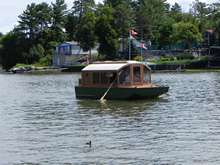 |
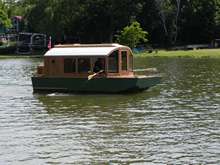 |
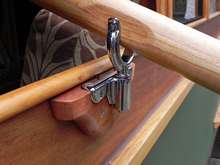 |
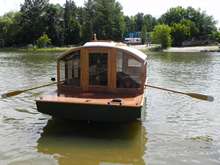 |
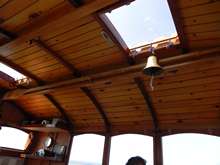 |
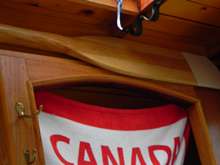 |
When I designed our Shanty Boat, DIANNE'S ROSE, the plan was to mount a trolling motor on the bow, to maneuver in shallow waters, like fishing boats do. It was also going to serve as back up to the Big Push. I've predictably changed my mind as a romantic image of Old Shanty Boats sunk deeper into my brain (my best ideas need time to percolate, another reason to slow down!). Last season, while using our newly built Camp Boat, I had the chance to experiment sculling from the bow, managing to move her around quite easily to new fishing spots. A loop of rope on the middle front cleat secured the shaft of a single oar. Worked back and forth, twisting the blade on each stroke pulled us forward. Working better than expected, I was convinced a good set of oars would work better still. I was fortunate a neighbour's Ash tree needing to be cut down. Striking a deal to do the work for free, I ended up with the wood. A portable mill cut it into 1" and 2" planks. It was used for the boat's flooring, runners and rub rails and would also be the perfect wood for oars.
This wood had been air dried, which is better than kiln dried (makes the wood brittle). Air dried maintains the woods flexibility so is ideal, but if you're looking to make your own set of oars use what you have. I created a cool jig to turn the handles down to 1 3/4" radius (a router bit could also be used to knock off the corners and hand tools could finish the round). My system involved a strong drill
(an old one with a broken switch), a 2" hole saw, a shaper and a wooden jig. The jig was key, made of plywood it allowed the square stock to be turned with the drill through a large diameter hole to fit the 2 X 2" square block. The hole saw, having screws into the wood through its slots, allowed the drill to be fastened to one end of this stock. The blank was then spun and moved forward into the spinning shaper blades. This cut away the corners leaving a round shaft. The back part of the jig had two more holes spaced apart to receive the finished 1 3/4" rounded stock. In theory these two holes would "tame" any vibration! Well not so much!!! We ruined the first attempt because the stock was so out of balance it almost shook my arms off! It didn't help that I had to plug my drill into a power bar to turn it off and on, because of the broken switch (where are those safety inspectors when you need them?)! I was in trouble because I walked past the power bar that sat on the floor so couldn't reach it to shut it off. My helper, Ben, "helped" and unplugged me before things got too exciting! Our first blank still had good sections so encouraged us to proceed. We learning from Ben's error (blame is important in woodworking as it is with all large corporations, the innocent low man must take blame ;-), this time I selected straighter material. Success!!! If I had to make more than two oars, I'm confident we would be able to perfect the jig and cutters to get perfect results every time. Needing only two, I was happy to do a little hand planning and sanding. The last 2' of shaft were left square, to epoxy on more ash to produce the blades. When the epoxy cured the blades were cut thin on the band saw and shaped. The previously mentioned jig was also used for the handles but with a router instead of the shaper. Again, some hand work was required.
Another cool jig was used to finish sand the shafts. Using an inside-out belt from a belt sander. The blades were further shaped using a power plane, spoke shave, belt sander and then a random orbital sander. Wow, we had a beautiful set of oars! They became more beautiful when they were oiled (1 part RAW Linseed Oil/1 part Turpentine). Allow it to soak overnight, then wipe with a rag to remove excess oil (dispose of the rag safely). Three coats of varnish and since I like the look of painted tips, we did this as the varnish cured. That's it! I was so excited with the results I thought I'd let you all know about it. I've used them rowing from the inside the boat as ancient societies have done for centuries. It moves the boat well and I've even made progress into the wind on a small lake. Dianne is getting into the spirit of my "old world" thinking and is considering getting a whip"!
|






